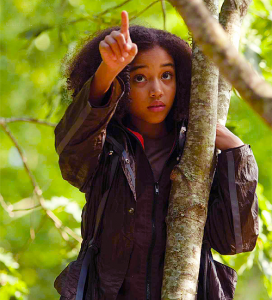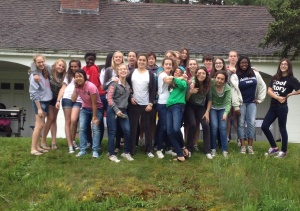Hungering for a Better World
Bill Ivey is Middle School Dean at Stoneleigh-Burnham School in Greenfield MA, where he also teaches Humanities 7, French I, and the Middle and Upper School Rock Bands — and co-teaches ESL Humanities. Bill is the advisor for MOCA, the middle school student government, and he coordinates and participates in the middle school service program.
Stoneleigh-Burnham School is a small independent school for girls in grades 7-12, founded in 1869. Bill is a bit younger than that. He was a charter member of our MiddleWeb e-listserv community, back in 1999, and helped organize several face-to-face gatherings of participants in that group. He continues to be active in its successor, AMLE’s MiddleTalk. This post first appeared at his school’s blog A View from the Nest.

For those unfamiliar with it, The Hunger Games is a book by Suzanne Collins that describes a dystopian future wherein children representing their geographical district, known as Tributes, fight to the death for the (sarcasm on) entertainment (sarcasm off) value. There are three books to the series, and of course, the eagerly anticipated movie “The Hunger Games” was released this spring. As a middle school teacher who follows members of the #nerdybookclub on Twitter, I couldn’t have missed the release date if I tried. Many of my friends were braving the masses at midnight showings, which were as crowded as they were festive.
But as the release date drew near, an unexpected and disturbing dynamic arose. “I was pumped about the Hunger Games. Until I learned a black girl was playing Rue.” “And for the record im still pissed that rue is black…” “EWW Rue is black? I’m not watching.” (tweets quoted in “Racist Morons React to The Hunger Games: Rue is Black“)
Yes, Rue is Black. The 12-year-old Tribute is so described in The Hunger Games on page 45: “She has dark brown skin and eyes…” (Collins). That so many people missed that altogether might be perceived as a hopeful sign we are nearing a truly post-racial era, were some of people’s subsequent reactions a little less, well, racist. But even in a positive context, it would seem to suggest that assuming white skin as a default is such a strong instinct for some people that even when evidence to the contrary is presented, they still miss it. That in itself reveals a certain systemic racism and privilege even among some of those people of good will who are sincerely committed to being anti-racist.
And so, on discussion boards, blogs, Tumblrs and other sites, the Internet (became) populated with comments left by people who were infuriated by the racism… of people pointing out instances of racism. “There are more blacks that are racist than white because they have the feeling everyone owes them something.” wrote Kay in commenting on a blog that (middle grades math teacher) José Vilson wrote for CNN, titled “My View: Are we doing enough to make sure our kids aren’t racist?” Later on, WCT wrote, “People who complain about racism are the ones who are only going to perpetuate it. As long as somebody is going to continue to complain about racism it is going to continue to exist. If you want racism to stop just shut up about it…”
Right. Because historically, ignoring prejudice has worked so well.
Facing up to reality
In point of fact, I would argue, the most positive changes have been made by people willing (and/or forced) to face up to reality. It is easy to decide you are or want to be anti-racist. It is much harder work to act in a truly anti-racist fashion. You have to acknowledge that you see race, examine the assumptions you make so quickly you might not even notice them if you weren’t looking, and then work both to excise those assumptions from your thinking and to, very deliberately, avoid acting on them.
One of the most moving comments on Mr. Vilson’s blog came from a 15-year-old named John, who wrote: “i am a 15 year old boy and i have struggled with racism for a while. im white and was grownup with a fine family. but my dad being racist rubbed off on me. same with his brother my uncle who is around. it has taken me nearly a year now to fix my racism problem… now that im way less racist i hate people who are open about it. i hate my old self…” As much courage as it took to write that, it was probably less than it took for him to face up to the problem in the first place.
Therein lies my hope that one day we can, as Mr. Vilson put it in a companion blog to his CNN piece, “The Dreamer, The Believer [The Race-Man Cometh],” “create new [realities] where we can simultaneously love one another and recognize that we’re the same and different at once.” My hope grows as I see my Humanities 7 class sharing knowledge about and a deep sense of sadness tinged with anger at the death of Trayvon Martin, as MOCA agrees to propose dedicating a day in support of Trayvon Martin, and for that matter as MOCA discusses the Day of Silence in support of LGBT people.
Those new realities of which Mr. Vilson and I — and most, if not all, of our students — dream won’t just happen by themselves, though. You have to build them slowly, moment by moment.































1 Response
[…] and participates in the middle school service program. Bill’s other MiddleWeb posts include Hungering for a Better World and Actually, You ARE […]